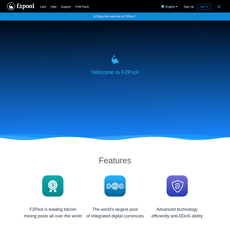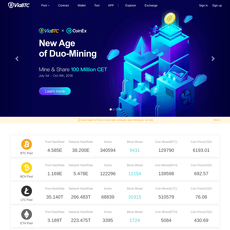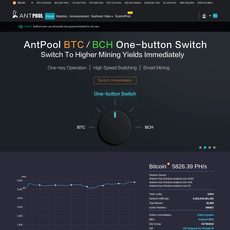SlushPool Review
SlushPool
slushpool.com
Slushpool.com Ultimate Guide Review: Everything You Need to Know
Ever wondered if Slushpool.com is the mining pool you’ve been looking for? Whether you’re just stepping into the world of cryptocurrency mining or you’re a seasoned pro, picking the right mining pool can feel like walking through a labyrinth. But don’t worry—I’ve got you covered!
In this guide, I’ll walk you through all the essentials about Slushpool that could make or break your mining setup. From its features and payouts to frequently asked questions, this guide is designed to leave no stone unturned.
Why picking a reliable mining pool matters
Mining isn’t just a "set it and forget it" kind of deal. It’s a deliberate choice that impacts your earnings—and, let’s be honest, your sanity. When you plug your hardware into a mining pool, you’re not just sharing your hash power; you’re entrusting your efforts to that pool. Choose wrong, and you could end up with slow payouts, high fees, or worse—losing out on potential earnings altogether.
Think about it like this: You wouldn’t park your car in a garage that doesn’t guarantee security. Mining pools work the same way. You need a stable, secure, and transparent platform. That’s where understanding your options becomes so crucial. And yes, fees and transparency matter A LOT. After all, Bitcoin mining is already energy-intensive, so you want every fraction of BTC earned to be worth it.
What you’ll get in this guide
This guide isn’t fluff—it’s actionable and straightforward. Here’s what’s coming your way:
- A detailed look at Slushpool’s features, reputation, and why it’s a favorite for so many miners.
- Breakdowns of fees, payouts, and rewards so you know where your efforts will get you the most bang for your buck.
- Answers to the burning questions people ask when they’re researching this mining pool.
Still on the fence about whether Slushpool could be your ultimate mining partner? Don’t worry; we’re just getting started. Up next, let’s explore what makes Slushpool tick. Ready to see what sets it apart from the rest? Keep reading!
What is Slushpool.com?
Slushpool.com is not just any Bitcoin mining pool; it’s one of the oldest and most respected names in the game. Many miners, both seasoned pros and curious beginners, trust this platform for its transparency and reliable payouts. But what really sets it apart? Let’s explore its origins, the features that make it special, and why it’s still thriving after all these years.
Quick Background and History
Launched way back in 2010, Slushpool has been around long enough to see the Bitcoin ecosystem grow from a niche idea to a global phenomenon. The platform was created by Braiins, a Prague-based software company, and holds the distinction of being the first-ever Bitcoin mining pool to exist. Yes, you heard that right—without Slushpool, mining as we know it today might look very different.
Its longevity isn’t just luck; it’s built on trust and innovation. Back in 2012, when pools were still new, Slushpool gained attention for being one of the first to solve the issue of "block-hopping" (miners jumping between pools for quick rewards). This ensures fairness and stability for everyone who contributes.
A decade later, it still holds strong among the top mining pools, boasting consistent features and a steady user base. Companies with years of history usually gain some level of skepticism, but Slushpool keeps proving its worth. As one miner put it, “If Slushpool were a person, I’d consider them the wise mentor of the mining world.”
Key Features
So, what’s under the hood of this iconic platform? Let me break it down into some standout features that attract miners every day:
- User-friendly Interface: First-time miners have it easy with Slushpool’s clean and intuitive dashboard. It’s perfect for beginners but advanced enough for experienced users to track performance efficiently.
- Customizable Payout Thresholds: Decide how much you want to earn before receiving your payout. Whether you’re mining in large or small amounts, this flexibility is a big plus.
- Mobile App for Real-time Monitoring: Imagine being able to check your hash rate and earnings while running errands—Slushpool’s app puts all this convenience in your pocket. Sadly, not every pool offers such sleek mobile technology.
- Transparency: Everything, from your earnings to fees, is laid out clearly. No guessing games or hidden costs here.
Who Uses It Today?
Why has Slushpool stood the test of time even as the competition grows? The simple answer—it meets the needs of nearly everyone:
- Beginners: If you’re just starting and want a trusted place to learn about mining pools, Slushpool is like your training wheels. It isn’t overwhelming, but it still gives you tools to see how you’re doing with your hash rate.
- Experienced Miners: For pros who value dependable payouts, Slushpool is a no-brainer. Its performance, transparency, and track record make it a common choice for miners with serious hardware setups.
- Global Users: With support in multiple languages and a worldwide user base, Slushpool caters to miners no matter where they’re based. They’ve been around long enough to understand what their community needs.
Over the years, Slushpool has quietly earned recognition for being a mining pool that anyone can trust. Whether you mine casually or take this as a full-time venture, it offers enough balance between accessibility and efficiency to stay relevant.
Still, how does its inner mechanism work, and what makes it tick? What happens behind the scenes when you contribute your hash rate to Slushpool? Stay tuned—you’re about to get the full scoop as we uncover the nuts and bolts of how this platform operates.
How does Slushpool work?
Ready to put your mining hardware to work? Let’s talk about how Slushpool operates at its core. It’s all about making things simple while maintaining transparency. I’m sure you’ve thought, “Can I really trust a pool to handle my hash rate and payouts?” Slushpool doesn’t just say yes—it shows you how.
How to start mining with Slushpool
Starting with Slushpool is easier than you might think. Whether it’s your first attempt at mining or you’re switching from another pool, the process is pretty straightforward. Here’s what you need to do:
- Sign up: Go to Slushpool’s official website and create an account. It’s quick, and the interface won’t confuse you with tons of unnecessary options.
- Set up your miner: This step depends on the mining hardware you're using—be it an Antminer or ASIC miner. Slushpool supports a wide range of compatible hardware. They even provide detailed configuration guides for beginners.
- Get your mining address: Copy the pool's mining server address for your region (Slushpool runs multiple servers globally). This ensures the lowest latency, which can have a small, but noticeable effect on efficiency.
- Personalize settings: Use Slushpool’s dashboard to customize your payout threshold or enable notifications to monitor your performance.
And that’s it—you’re ready to mine! Simple enough for newbies, yet reliable for veterans.
Hash power and rewards
Now, let’s talk hash power and what you’ll get in return for it. Slushpool uses a scoring system called “Score-based reward distribution.” This system ensures your work is credited fairly. Unlike traditional methods, it reduces the impact of pool hoppers (users who join multiple pools for short-term gains), which translates to more stable earnings for you.
Here’s how it works:
- When you contribute hash rate to the pool, your score increases based on the duration and amount of work your miner contributes.
- The rewards are distributed according to your score once a new block is mined and confirmed.
- This system rewards consistent mining, making it ideal for people who want long-term payout stability.
Users often report that their payouts are reliable and match their expectations. According to a study on mining pool reward systems, this score-based method is one of the fairest in the industry, as it balances incentives for both consistent and high-powered miners.
“Don’t work harder, work smarter—Slushpool ensures you’re rewarded for every hash without unfair losses to pool jumpers.”
Comparing to other pools
I know what you’re probably thinking—how does Slushpool stack up to competitors like Foundry or Antpool? The short answer is, it depends on your priorities. Here are some quick points to help you understand:
- Foundry: Foundry is well-known for having zero pool fees but lacks the same level of robust user customization settings that Slushpool offers. If you like to tweak your mining process, Slushpool wins here.
- Antpool: Antpool may offer competitive payout models, but transparency is a key area where Slushpool trumps it. Miners frequently note how Slushpool’s interface and reports make tracking their progress effortless.
- Community and support: Slushpool’s long-standing reputation means it has a solid community and support base, making troubleshooting less of a headache compared to newer or less-documented pools.
At the end of the day, picking a pool is about aligning your priorities. Whether it’s transparency, fair rewards, or ease of use, Slushpool has a unique offering compared to the competition. Still, wondering why fees matter or what you’ll pay to withdraw? Let’s get into the details next—you might be surprised at what you won’t pay for.
Fees and Withdrawal Details Explained
You’re mining hard-earned Bitcoin, and the last thing you want is for unnecessary fees or complicated withdrawal processes to steal a chunk of your earnings. So, let’s break down Slushpool’s fees, payout methods, and limits so there’s zero confusion. Transparency is key, and let me tell you—this part matters more than most realize.
What are the fees?
Alright, here’s the upfront deal: Slushpool charges a 2.5% pool fee. It’s stable, predictable, and doesn’t come with hidden surprises. Is that too high? Compared to some smaller or newer pools, maybe—though it’s pretty standard for most top-tier mining pools. This fee covers pool operations, security, and services like monitoring tools and user-friendly dashboards.
To put it in perspective, say you’re mining with a hash rate that earns you 0.01 BTC per payout cycle. At 2.5%, you’re looking at 0.00025 BTC being deducted as the fee. For some, that trade-off might feel worth it considering the pool’s reliability and transparency. And honestly, this is where you weigh what fits your priorities—reliability or slightly cheaper fees?
On-chain payouts vs. Lightning payouts
This is where things get really interesting. Slushpool offers two payout methods, and picking the right one could save (or cost) you more than you think:
- On-chain payouts: This is your classic Bitcoin transfer to your wallet address. The minimum withdrawal amount is 0.0002 BTC, but here’s the kicker—if your withdrawal is under 0.005 BTC, you’ll pay a 0.0001 BTC fee. Above 0.005 BTC? It’s free. This method is perfect for stacking up larger amounts if you want to avoid additional transfer costs.
- Lightning payouts: Faster, leaner, and ideal for those who hate waiting. With no lower limits, you can withdraw even tiny amounts, making it perfect for miners who don’t want their rewards sitting idle. However, keep in mind that Lightning transactions come with network-specific fees, depending on how saturated the network is.
So, which is better? If you’re all about speed and microtransactions, Lightning is your go-to. But if you’re maximizing every satoshi and don’t mind waiting, on-chain payouts are the smarter bet.
Summary of withdrawal limits
Let’s nail down the numbers, so there’s no guesswork:
- On-chain payout minimum: 0.0002 BTC
- No fees for on-chain withdrawals over 0.005 BTC
- On-chain fee for payouts under 0.005 BTC: 0.0001 BTC
- Lightning payouts: No minimum withdrawal limits, but fees depend on network conditions.
Here’s where you need to be strategic. If you’re mining smaller amounts, Lightning might save you from the 0.0001 BTC fee. But if you’re sitting on a bigger stash, it’s worth waiting for the free on-chain transfer above that 0.005 BTC threshold. Decisions, decisions.
As a miner, it’s always about optimizing your earnings.
“It’s not just about what you earn—it’s about what you get to keep.”
Fees, limits, payout types… these details might seem small, but they can make a massive difference over time. Are you really mining efficiently if your transaction costs eat into your rewards?
But is this trade-off of higher pool fees worth Slushpool’s reputation and payout flexibility? And what about other mining pools? Does Slushpool have enough pros to outweigh its cons? That’s exactly what we’re getting into next. Stick around to see if this pool stacks up for your mining goals.
Pros and Cons: Is Slushpool the Right Fit for You?
When you’re picking a mining pool, it’s not just about crunching numbers and comparing fees. You want a platform that feels reliable, efficient, and, let’s be honest, worth your time. Slushpool ticks a lot of the right boxes, but like any service, it has its pros and cons. So, let’s break it down to help you figure out if it’s the match for your mining goals.
The Good Stuff
There’s a reason Slushpool still stands tall as one of the oldest Bitcoin mining pools. It offers several benefits that miners appreciate. Here are some highlights:
- Steady Reputation: In a world where crypto platforms often come and go, Slushpool’s long-standing reputation speaks volumes. It’s been around since 2010, making it one of the most trusted names in mining.
- Low Withdrawal Fees for High Payouts: If you consistently mine larger amounts, you’ll love the fact that payouts over 0.005 BTC are free when using the on-chain method. This can save you money over time compared to other pools.
- User-Friendly Platform: Whether you’re monitoring your miner stats on the mobile app or customizing payout thresholds, the platform is incredibly intuitive.
- Advanced Security Features: Slushpool uses two-factor authentication and has a strong focus on protecting your earnings and credentials.
Here’s an interesting note: Many miners feel a sense of “security in tradition” with Slushpool. There’s comfort in knowing the platform has weathered storms in the volatile crypto world. One user even remarked, “Slushpool feels like the backbone of my mining operation. It doesn’t disappoint.”
Where It Falls Short
No mining pool is perfect, and Slushpool is no exception. There are a few areas where it doesn’t shine as brightly:
- Higher Pool Fee: Slushpool charges a 2.5% pool fee, which is on the higher side compared to some competitors like Foundry. For miners working on tight profit margins, this can be a significant factor.
- Lack of Profitability for Everyone: While reliable, Slushpool might not suit everyone, especially those with low-end mining hardware or those aiming for the highest profits at the lowest costs.
- No Exotic Crypto Mining: If you’re into mining a variety of altcoins, Slushpool is strictly focused on Bitcoin and Zcash, which could feel limiting for some.
These aren’t dealbreakers for everyone. However, if you’re laser-focused on minimizing costs or experimenting with multi-coin mining, Slushpool might feel a bit restrictive. Remember, numbers don’t lie—always calculate if the fees and hardware requirements align with your strategy.
Final Thoughts on Usability
Now, let’s talk about what it’s actually like to use the platform. Slushpool has a clean, easy-to-navigate interface that beginners quickly get the hang of. It’s also versatile enough for long-term miners who value advanced features like customizable payout thresholds. But keep this in mind: If you’ve only got basic hardware and no patience for calculating costs, Slushpool might demand a little more attention than you’re ready to give.
On the other hand, if you’re serious about mining and looking for something that has stood the test of time, it’s hard to argue against Slushpool’s stability. This is especially true when payouts are steady and transparent.
“Choosing the right mining pool is like choosing a business partner. Go for reliability over hype.”
So, here’s my question to you: Is Slushpool’s consistency and trustworthiness enough to outweigh its slightly higher fees? Or is the excitement elsewhere calling your name? Let’s compare this with what some other pools bring to the table, and it might finally answer the question that’s been on your mind: Is Slushpool truly worth it?
How does Slushpool compare to other mining pools?
When it comes to picking the right mining pool, you probably wonder: "Is Slushpool better, or should I go with that other popular platform I’ve heard about?" Trust me, you’re not alone. Let’s check out how Slushpool stacks up against its competition and whether it holds the edge you’re looking for.
The competition at a glance
There are plenty of noteworthy mining pools out there, and they’re all trying to win over your hash power. Let’s talk about three big names: Foundry, Antpool, and ViaBTC. Here’s a quick look at how they compare:
- Foundry: Popular for its rock-solid hash rate and reliability, Foundry often boasts one of the largest chunks of Bitcoin network power. However, the platform doesn’t exactly scream “user-friendly,” so beginners might find it tough to navigate.
- Antpool: Backed by the creators of some of the world’s best mining hardware, Antpool offers flexibility with its no-minimum payout options. That said, it has higher fees compared to Slushpool.
- ViaBTC: Known for offering rewards in multiple coins beyond Bitcoin. It’s great for variety, but its dual mining options might not suit everyone depending on their hardware or goals.
Each of these pools brings something unique to the table, but the question is: does Slushpool offer that “balance” you need between performance, ease of use, and cost?
Why some stick with Slushpool
Here’s the thing: Slushpool has a reputation. Its name carries weight because it’s been around for over a decade, making it one of the most established players. Now, while new pools pop up trying to wow miners with flashy features, there’s something comforting about sticking with a platform that’s stood the test of time.
Miners who stay loyal to Slushpool often do so because:
- They trust its transparency. No sneaky algorithms, no beating around the bush; you know exactly how fees and payouts are calculated.
- Consistency. While some rivals boast higher short-term profits, Slushpool focuses on steady, predictable payouts. That’s golden for long-term miners.
- Support for beginners and veterans. Tools like a user-friendly dashboard and mobile app make it accessible, but it’s also powerful enough to satisfy experienced users.
Here’s a quote I love:
"Hard-earned trust beats short-lived excitement."
When it comes to Bitcoin mining, some miners stick with Slushpool simply because reliability can mean everything in this energy-intensive game.
Is it the most profitable option?
This depends on what you’re looking for. Let’s keep it real – there are pools out there that might give you a tiny bit more profitability if your setup is ideal. But is that always realistic?
If you’re someone chasing every last satoshi, a pool like Antpool might seem tempting with its pay-per-share models. However, if you value trust, consistency, and a rock-solid platform, Slushpool has you covered.
Ultimately, profitability isn’t just about the fees or payout models; it’s about how Slushpool’s reliability and predictable payouts fit into your goals. Whether you’re mining casually or stacking sats for the long haul, it’s essential to decide what matters most to you.
But here’s the big question: Does choosing Slushpool mean you'll be minimizing your risks while maximizing your results, or is there an even better pool out there waiting for you? And hey, what about those fees—do they stack up in the long run? Let’s tackle that next in the FAQs where I'll answer those burning questions miners like you always ask.
FAQs about Slushpool
When considering Slushpool as your potential mining pool, it’s natural to have plenty of questions. Some of these questions are asked so often that it’s worth addressing them in detail. Let’s clear up some confusion so you can better understand whether this is the right fit for your mining needs.
"How much is Slushpool’s withdrawal fee?"
One of the first questions everyone asks is about fees, and for good reason—fees eat into your earnings. Slushpool charges a 2.5% pool fee. But here’s the kicker: if your payout is over 0.005 BTC and you go for an on-chain withdrawal, it’s completely free. Withdraw amounts under 0.005 BTC, however, will incur a charge of 0.0001 BTC. So, if you’re planning to withdraw regularly in smaller amounts, keep this in mind—it might be better to wait until you accumulate a larger balance to minimize costs.
For example, let’s say you mined 0.004 BTC, and you withdraw it using on-chain payouts. That withdrawal will cost you 0.0001 BTC, leaving you with 0.0039 BTC. But if you wait until you cross the 0.005 BTC mark, you get the entire withdrawal without any additional charges. Timing is everything!
"Is joining a mining pool like Slushpool worth it?"
Great question. Whether joining Slushpool—or any mining pool for that matter—is worth it often depends on your goals. Pools like Slushpool bring some real benefits to the table: you get better chances at consistent payouts, top-notch transparency, and tools designed to maximize your mining efficiency.
Think about it like this: mining solo is equivalent to chasing a lottery win. Sure, it’s possible, but the odds are stacked against you. With a pool, you’re part of a team, and while you share the rewards, you also share the workload and minimize risks. It’s about playing smart, especially in a competitive environment like Bitcoin mining.
In Slushpool’s case, its strong reputation and features make it a solid choice for individuals or even smaller operations looking for steady and reliable returns. As they say, "Security lies in trust," and Slushpool’s transparency has earned it plenty of trust within the mining community over the years.
Other important queries
Let’s answer some of the other common questions about Slushpool and mining pools in general.
- Does it cost money to join a mining pool? Joining Slushpool itself doesn’t cost anything upfront. The fee comes into play when you start earning—you’re charged the 2.5% pool fee on your mined rewards.
- Is Bitcoin mining still profitable with pools? The answer here largely depends on your electricity costs, hardware efficiency, and market conditions. But here’s the good news: mining pools generally increase your profitability simply because they help you earn more consistently. Slushpool’s methods for distributing rewards are built to be fair and user-friendly.
- What equipment works best? Bitcoin mining today requires highly efficient ASIC miners. Some popular models like the Antminer S19 or Whatsminer M30S are great options. Pairing quality hardware with a reliable pool like Slushpool can maximize your earnings. Keep in mind that older or less powerful machines might struggle to stay profitable due to electricity usage.
"A question opens the mind, a statement closes it." – Voltaire
Just asking the right questions about your mining pool can make all the difference in your profitability. Have you considered the timing of your payouts, hardware compatibility, or how pool fees add up over the long run?
Looking for more guidance or resources to sharpen your decision-making? Don’t worry—I’ve got some excellent links and sources lined up for you. Ready to see where you can find them? Let’s go, the next section is going to be packed with actionable info you can trust.
Resources to Check Out
If you’re serious about maximizing your mining efficiency and have been wondering whether Slushpool.com is the right choice, then doing your homework is the next best step. I know—you’re already knee-deep into this guide, but trust me, checking out a handful of other trusted resources will help you make even better decisions. The more you know, the easier it is to fine-tune your approach to mining.
Why Research Matters
Picking the wrong mining pool can hurt—financially and mentally. Slow payouts? High fees? Unreliable servers? If a pool is riddled with issues, it could mean all your hard work barely yields any fruit. Research helps cut through the noise and ensures that you’re not blindly throwing your hash rate at just any platform.
Even if you’re sold on Slushpool’s decades-long reputation (and it’s a solid one!), understanding what other miners are saying about their experience adds another layer of confidence. You’ll find tips others discovered the hard way and maybe even spot hidden gems you wouldn’t have known otherwise.
A Friendly Tip Before You Click Away
You’ve got some top-notch resources to explore now, and I recommend bookmarking them if you’re taking your research step by step. But let’s not stop here. Have you ever wondered how profitable Slushpool really is compared to other mining pools? Or whether you might make even more by tweaking your mining strategy with them? Stick around—I’ve got answers coming up!
Final Take: Is Slushpool Worth Your Hash Rate?
So, here we are—the final question: Is Slushpool the right mining pool for your efforts? After exploring all the details, it’s clear that Slushpool is a reliable platform with years of experience under its belt. But like everything in crypto, it’s not a one-size-fits-all answer. Let’s break it down one last time to help you decide.
A Reliable Option, But Not Perfect
Slushpool stands out for its steady payouts, transparent operations, and long-standing reputation in the mining scene. It’s the pool that many miners trust, especially those who value dependability over flashiness. If you’re someone who hates surprises when it comes to fees or payout consistency, this pool ticks those boxes.
But let’s not ignore the obvious drawbacks. Its 2.5% fee might feel a bit heavy compared to other mining pools, especially for those who prioritize squeezing out every little bit of profit. There are other pools with lower fees, so you’d need to weigh if Slushpool’s transparency and reliability justify the cost in your specific situation.
Considerations Before You Start
Before committing to Slushpool—or any other mining pool for that matter—there are some things you should really think about to maximize your success:
- Hardware Readiness: Ask yourself, is your mining rig up to the challenge? Pools like Slushpool perform best with solid hardware that churns out respectable hash rates. If you’re rocking older or less efficient miners, profitability could take a hit.
- Compare a Few Pools: Even if Slushpool looks like a good fit, don’t skip doing your homework. Check out its competitors, like Foundry or Antpool, and consider what works better for your mining goals—fees, payout structures, or hash rate distribution.
- Understand Payout Methods: Watch out for those payout thresholds (like the 0.0002 BTC minimum for regular payouts and the unique Lightning payout options). Make sure you understand what fits your cash flow needs before jumping in.
Taking a little extra time to compare and ensure your setup matches your chosen pool’s requirements can save you stress down the road.
Your Mining Journey Starts Now
At the end of the day, Slushpool has built a stellar track record, offering a solid platform for both beginners and experienced miners. If you value security, transparency, and reliable payouts, it’s hard to go wrong with it.
But if you’re laser-focused on chasing the highest possible profits, you might want to explore other options alongside Slushpool. The good news? Crypto mining is flexible. You’re not tied down forever—try it out, monitor your results, and adjust your plans as needed.
No matter which route you take, the key is to start. Research, prep your hardware, and get mining. Your journey into Bitcoin mining is only just beginning, and pools like Slushpool are here to make that journey a little simpler, and hopefully, more rewarding. Good luck!
For the most comprehensive, up-to-date list of vetted mining pools—complete with profitability calculators and hardware recommendations—visit CryptoLinks.com. We've done the heavy lifting so you can mine smarter!







